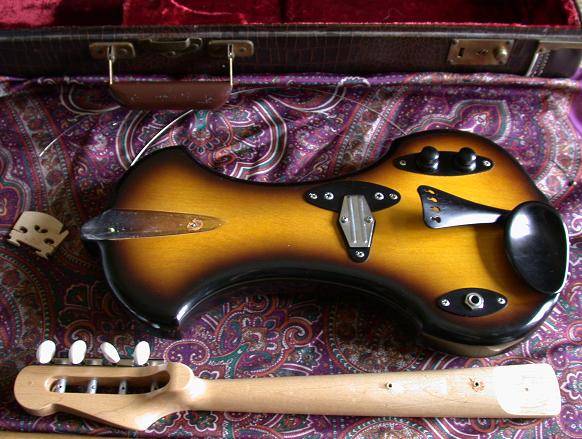1950s - 70s
Lazaro
for the sake of greater clearness and to make it easier to understand the invention is described as applied to any instrument of the violin type...
*
Clarence Leo FENDER - USA 1958
Electric violin.
Clarence Leo Fender submitted his patent in June 1958 for an electric violin which was granted in 1961.
An object of the present invention is to provide an improved electric violin which may be mass-produced economically and with a very high degree of predictability and uniformity of tone
Leo Fender’s autobiography records that the electric violin was tried by a few bluegrass fiddlers at a festival in Nashville but although the sound was considered good, the weight ( almost two pounds ) was a problem. Whether it ever made production is yet to be proved. Seemingly up to 200 were made but until more appear on the world's market, in museums or galleries this becomes more doubtful. Maybe five are known, at the time of this writing though only one for absolute certain. The project was shelved until the mid nineteen seventies. The appearance of the Fender electric violin combines elements of previous makers. It looks like a compromise between having no body and maintaining a traditionally shaped instrument. The main features of the 1961 instrument are the inner-bouts which appear considerably stretched along their length and the scroll which is a miniature classic-Fender guitar headstock. This idea of instrument design can be seen in some of today’s instruments (ZETA and Bridge Instruments).
*
Max. MATHEWS. Bell Laboratories, USA 1972.
Electronic violin.
In the early nineteen seventies Max Mathews developed an electric violin with a separate pickup for each string much along the lines of Compton but positioning the pick up in the bridge, under the strings. Mathews and advocates of his violins (principally Negysey) have contributed essentially to the development of an electric violin technique.
In this age of the electrified sound, the professional violinist has been slow in accepting or experimenting with the so called 'electric' violin. Part of the problem could be simply with the quality of the sound that it is capable of producing... The problem of the violin as it is today in meeting future musical needs is two fold : first is the matter of supply and demand of fine instruments; second, the need of the modern soloist... the electronically adjusted instrument is worthy of serious consideration by the string world - Dr. Eugene Gratovich (1973).
The following is taken from a published interview with Mathews.
The electronic instruments all have regular violin strings and they all have bows. So the source of the vibrations is the same as in a regular violin. But thereafter the sound gets modified electronically. It is possible to tune the resonances very accurately, and it is, of course, possible to have as much energy in the sound...
And from an article discussing a piece of music written specially for the Mathews violin :
By merely amplifying the instrument, for example, a world of sound heretofore imperceptible becomes part of the composers palette... Electroacoustic violins have been used quite extensively in performance, although not so much in ‘art music’ circles. Still, given the fact that most serious ‘music lovers’ are exposed to the classical violin literature through records, tapes, and radio broadcasts, in reality the average ‘guy on the street’ turns out to be more familiar with the sound of an amplified violin than the sound of an acoustic one...
All of Mathews' electronic violins use regular violin strings, and the violinist plays and holds the instrument in a traditional manner. Therefore, like an acoustic violin, the source of vibration and the playing technique are identical. However, there is one important difference. Since no acoustic energy is actually supplied by the vibrating string, as is the case with an acoustic violin, the electronic instrument both speaks faster and requires less bow pressure. - Richard Boulanger (1986).
*
Ivan DODSON - USA c.1974
Last known address - 212 Dellview Ave., Santa Cruz, California 95062
*
R. Kent ALBIN - USA c.1975
Last known address - 1458 Haight St., #1, San Francisco, Calif., 94117
*
Robert J. WILLCUTT - USA c.1977
Last known address - 443 S.Ashland Ave., Lexington, KY. 40502
*
XINDE International, Inc. - USA c.1978
Last known address - Walker Dr., Upton, Mass. 01568
*
data -
electric violin -
makers
BAH

This work is licensed under a Creative Commons Attribution-NonCommercial-NoDerivs 2.5 License.
up
